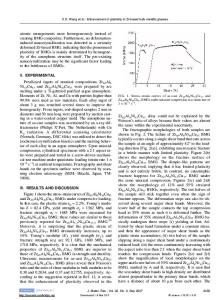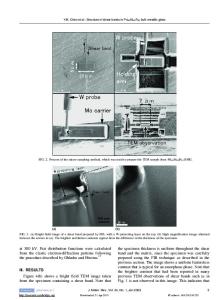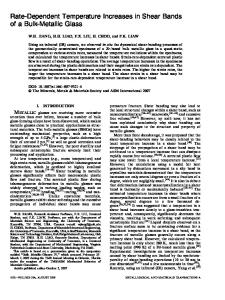Slithering of Shear Bands Can Improve Plasticity in Bulk Metallic Glasses
- PDF / 197,670 Bytes
- 2 Pages / 576 x 783 pts Page_size
- 92 Downloads / 311 Views
between SSRs, as demonstrated through simulations and measurements. The researchers conclude that by combining two SRR metamaterials, one with negative μ and the other with negative ε, a 3D negative index material could be achieved. In addition to the media-favorite of invisibility cloaking, such a material could find application in optical computing, nanoscale imaging, and high-speed communications. ALISON HATT
Atomistic Approach Predicts Resonance Frequency of Viral Capsids for Mechanodestruction Treatment Viruses cause many severe diseases for humans, animals, and plants, adversely affecting public health and agricultural production. Treatment options for viral infections are typically based on drug chemotherapies or vaccines, which often lead to negative side effects. Furthermore, mutations in the virus structure may make vaccines ineffective. Recently, researchers have proposed to attack viruses not through chemical but through mechanical means, by using hypersound, T-rays, or light scattering radiation. These methods are based on the idea to excite lowfrequency mode vibrations at their resonance frequency, which leads to rupture of the viral capsid structure and thereby a destruction of the virus. A similar phenomenon is known at macroscopic scales from bridges and buildings, which may suddenly collapse if excited at their resonance frequencies by wind loads. In order to optimally apply this new treatment option, it is desirable to know the resonance frequencies of the virus structure. How can one predict these resonance frequencies, provided the atomic structure of the virus is known? In the January 18 issue of Physical Review Letters (028101; DOI: 10.1103/PhysRevLett.100.028101), E.C. Dykeman and O.F. Sankey of Arizona State University describe a new computational method to predict the low-frequency vibrational modes of biological structures based on their atomistic geometry. The new approach is based on an energy functional from electronic structure theory and provides a much more efficient strategy to analyze the atomistic properties of virus vibrations than earlier attempts. The method is robust and is now being applied to plant viruses (e.g., cowpea chlorotic mottle virus), bacteriophages (e.g., M13 bacteriophage), and human viruses (e.g., polio and hepatitis B). A significant advantage of Dykeman and Sankey’s approach is that it allows 166
for an all-atom description of the vibrational mode patterns based on the atomistic structure of the virus, which can be obtained from an x-ray diffraction analysis of the virus geometry. Using the new approach, Dykeman and Sankey calculated the vibrational modes of the satellite tobacco necrosis virus based on the atomistic geometry obtained from an earlier x-ray diffraction analysis. Their calculations result in the prediction of the specific resonance frequencies of excitation that will most likely lead to a destruction of the virus. It also provides insight into the particular molecular deformation mechanisms, such as shearing of beta-sheets. This new tool coul
Data Loading...










